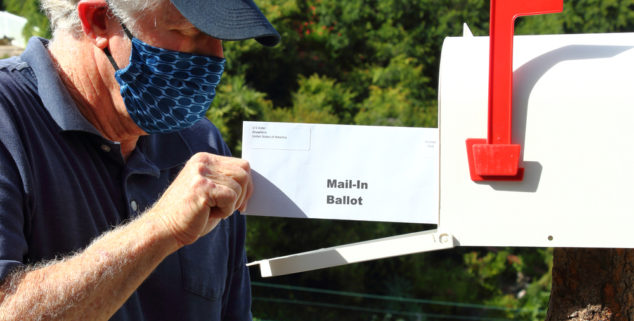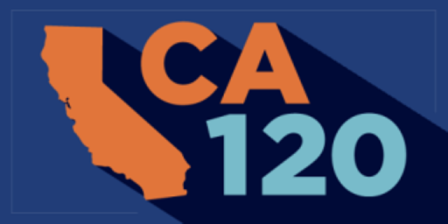News
CA120: A historic flood of over 5 million mail-in ballots
 A man mails in his ballot in the era of the pandemic. (Photo: Wayne Via, Shutterstock)
A man mails in his ballot in the era of the pandemic. (Photo: Wayne Via, Shutterstock)Over five million California voters – nearly a quarter of the state’s registered electorate — have returned ballots for the General Election, which is less than two weeks away. This milestone, hit yesterday at 13 days until the election, wasn’t achieved in 2016 until the day before the election and exceeds the entire early by-mail vote in 2018.
The scale of returns is staggering: At 13 days out in 2018, just around a million voters had returned ballots, while in 2016 it was just cresting 1.8 million. You can find the updated tracking of early votes here, and, for comparison, the 2016 tracker can be found here.
Some observers point to the fact that California is mailing ballots to all active registrants this year, and suggest that looking to those past elections isn’t a perfect comparison.
This is only partially true. In past years there were fewer ballots mailed, but the state was still largely vote by mail.
In 2016, 61% of voters received by-mail ballots, and in 2018 that figure was 68%. In the most recent primary, 75% of votes were cast by mail or at a dropbox using a mail-in ballot. Only a fraction of the rapid rate of early returns can be attributed to the increase in vote-by-mail alone.
Aside from sheer magnitude, the electorate so far has one stand-out element that significantly departs from prior elections: Partisanship.
Democrats are dramatically overperforming in the early returns, while Republicans appear to be holding back. This is something that we had projected could happen in this election cycle due to dueling conspiracy theories, wherein Republicans fear voting by mail is rife with fraud and so want to vote in person, while Democrats fear postal delays are designed to stop their votes from being counted.
The early vote is strongly skewed Democratic, with 56% of the early vote coming from Democrats, despite only being 46% of registrants.
Polling conducted by Capitol Weekly last month showed polarization around voting methods, with 79% of Democrats saying they wanted to vote by mail or using a dropbox, and 67% saying they would vote as soon as they received their ballot.
This is in stark contrast to many Republicans saying that they preferred voting later, and 44% specifically stating they wanted to vote at a polling place on Election Day.
This polarization of voting method is creating an early vote that is strongly skewed Democratic, with 56% of the early vote coming from Democrats, despite only being 46% of registrants.
Comparing the last two statewide elections, we can see that the first five million ballots in each of those cycles showed nearly identical representation for Republicans at above 30% of early returns, several points over their share of registration, while Democrats comprised 45%-46% of the vote, more in line with their share of total voter registration.
Partisanship of First 5 Million Ballots 2016-2020
| Dem | Rep | Other | |
| 2016 | 46% | 32% | 22% |
| 2018 | 45% | 31% | 24% |
| 2020 | 56% | 21% | 23% |
Essentially, Republicans are shipping 20 points to Democrats: In both 2016 and 2018 Democrats had a 14-point advantage within these by-mail populations, but this year it is a 35-point margin.
While these early Democratic numbers might be giving great hope to Democrats, there are plenty of reasons for them to temper their excitement. The fact is, these early Democratic voters look to be primarily high propensity voters adept at voting by mail. Unless lower-turnout voters and those who haven’t voted by mail before participate, this could be a case of the early vote cannibalizing the late and Election Day vote from Democrats.
Seniors are 22% of all registrants, but are 38% of those who have returned a ballot.
This underlying nature of the early electorate spans across a number of the metrics most commonly used in analyzing the early vote.
More than 90% of the votes cast so far are from those who are in one of Political Data’s likely voter universes. Nearly half the vote has come from voters flagged with “early vote” scores based on their patterns of voting by mail within the first 10 days in past elections. More than 80% of the votes cast are from voters who have previous experience voting by mail, and among those eligible in 2016, their turnout in that election was over 90%.
In addition, the early vote has a similar demographic trend seen in prior elections. Seniors are 22% of all registrants, but are 38% of those who have returned a ballot. Conversely, 18-34 year-olds are 30% of voters and just 17% of those who have returned ballots. Latinos are turning out in higher raw numbers than ever before, but while they are more than a quarter of the electorate they are less than a fifth of the votes cast.
Homeowners are overperforming by 10-points, while renters are underperforming by 2-points.
So, while the high turnout so far is a positive sign of enthusiasm and that some voters are receiving the messages to vote early, it doesn’t guarantee a wave where we see a significantly changed electorate from prior similar election cycles like 2016.
The state has emphasized that in-person voting is available for all, but that does not mean it will be as accessible as in a normal election.
In the next 10 days or so we should learn if unlikely voters will actually show up for this election by using the vote by mail or local drop boxes. We will also have to watch for late and Election Day votes, particularly those coming in from Republicans who might be holding on to their ballots.
For both partisan camps there should be significant concern about their eventual turnout. The greatest concern could be how accessible Election Day in person voting is for those who aren’t willing to vote by mail or use a local official dropbox location.
The state has emphasized that in-person voting is available for all, but that does not mean it will be as accessible as in a normal election. The number of voting locations has been slashed, with Vice reporting California has reduced in-person voting options by 73%.
Not only will there be fewer locations, each location will also have fewer voting machines because of the need to keep voters distanced, and the in-person voting process is being slowed down by processes necessary to protect the public and poll workers.
The critical lower-turnout voter universes have yet to show up, and some potentially extraordinary pressures on our election system are still to come
This could create extraordinary long lines, something most California voters have never experienced except at Disneyland. And this could especially impact suburban communities with higher concentrations of Republican voters given the early by-mail trends and research suggesting many still want to vote in person.
Additionally, since every voter was mailed a ballot, in many counties the voter will be required to relinquish their by-mail ballot if they want to vote in person. If they can’t relinquish a ballot, they will need to vote provisionally. These votes will still count, but it will be another point of frustration on Election Day for voters who choose not to cast their by-mail ballot or use a dropbox.
California voters have had it easy compared to voters in other states, and we don’t know the impact on final Election Day turnout if voters begin hearing complaints about long lines and provisional ballots, particularly for those who have never experienced any problems at the polls.
With less than two weeks to go in this historic and greatly anticipated election, there is reason to celebrate the early engagement by so many voters. But the critical lower-turnout voter universes have yet to show up, and some potentially extraordinary pressures on our election system are still to come.
—
Editor’s Note: Paul Mitchell, a regular contributor to Capitol Weekly, is the creator of the CA120 column, vice president of Political Data, Inc., and owner of Redistricting Partners, a political consulting firm.
Want to see more stories like this? Sign up for The Roundup, the free daily newsletter about California politics from the editors of Capitol Weekly. Stay up to date on the news you need to know.
Sign up below, then look for a confirmation email in your inbox.

Leave a Reply